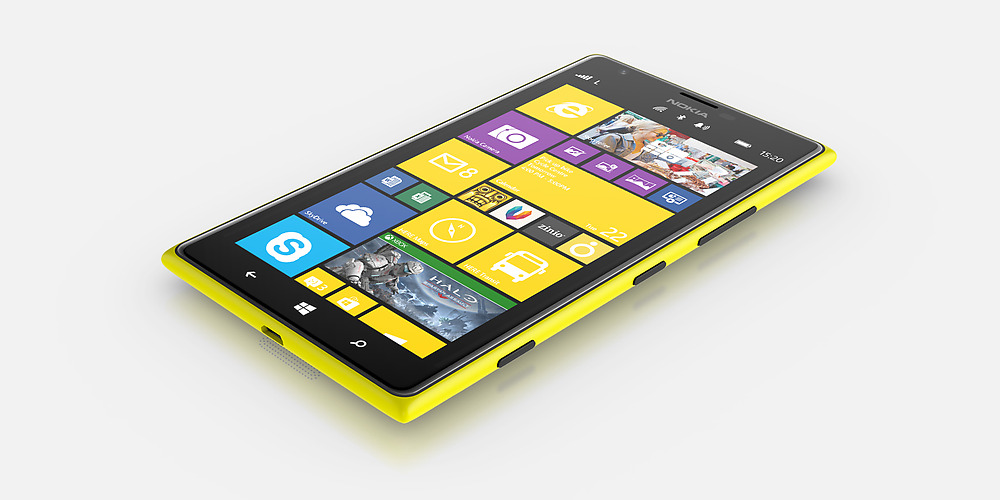
It seems like only yesterday Nokia was unveiling the Lumia 800, a stunning piece of industrial design that, for many, was an introduction to Microsoft’s Windows Phone. Now, just two years later, it’s strange to think on how many devices the two companies have collaborated, and that Nokia, once the largest manufacturer of smartphones in the world, is poised to be absorbed into Microsoft’s Products & Services division.
Early today, in Abu Dhabi, Nokia’s outgoing CEO, Stephen Elop, introduced the Lumia 1520, along with two other devices, the mid-range Lumia 1320 and the Windows RT-powered Lumia 2520 tablet.
The Lumia 1520 establishes Nokia’s dominance of the Windows Phone ecosystem by introducing not only new hardware, but Microsoft’s newest software version, GDR3, which supports 1080p displays and quad-core processors. With a 6-inch 1920×1080 pixel ClearBlack IPS display, a Snapdragon 800 SoC, 2GB of RAM, 32GB of internal storage (plus a microSD slot), a 3400mAh battery rated at 25 hours of talk time, and a 20MP PureView camera, this is definitely Nokia’s most fully-rounded smartphone.

Let’s start with the processor. Not only does the Snapdragon 800 allow the company to do some amazing things with its newly-announced Nokia Camera software — ReFocus is a Lytro-like feature that lets users change focus after the photo has been taken — but Nokia is adding RAW support to the Lumia 1520 (and 1020, albeit at a slower speed) with minimal lag. There’s also the 2-3x jump in raw processing speed from the last-generation Snapdragon S4 of the Lumia 920 and 1020, which was cowed not only by an aging first-generation dual-core Krait CPU but an 18-month old Adreno 225 GPU.
The new CPU/GPU combo also enables smooth scrolling and quick app load times at the screen’s native 1080p resolution, and Nokia worked with Microsoft to not only expand the breadth of icons on the home screen — there’s room for three horizontal tiles now — but to make better use of the screen’s size and density in apps like Email and Calendar. Developers may need to tweak their apps to run optimally on the larger and higher-resolution display, but it’s clear there is already some interest from high-profile companies.
Nokia’s Lumia 1520 also introduces a new, slightly smaller 20.7MP camera sensor with Carl Zeiss optics which, like the 1020, produces 5MP images through a process called interpolation, or pixel binning. This ensures that, though the photos are physically smaller, they contain far more detail than the average smartphone-taken shot, especially when taken in low light. It allows for 2x lossless zoom (as opposed to the 3x on the 1020) and performance from the newly-consolidated Nokia Camera app (which combines Smart and Pro Cams into one app) is much better than its predecessor’s, which necessitates a decent wait between photos.
While the sensor is a smaller 1/2.5 inches compared to the 41MP Lumia 1020’s 1/1.5 inches, and the aperture slightly slower at f/2.4 compared to f/2.2, this is still one of Nokia’s best camera experiences, and the Lumia 1520’s body is a svelte 8.4mm. Of course, it still produces excellent 1080@30fps video, and there are four microphones on the device for clear audio capture and noise suppression. Unfortunately, users also lose the Xenon flash of the Lumia 1020, replaced with a still-capable dual-LED flash module.
Lastly, Nokia has introduced Storyteller, an app that combines the imaging prowess of the camera with the location expertise of HERE Maps. It’s a bit of journal-meets-social network, and it looks quite interesting.
This is a very interesting product from Nokia; too big to be merely a smartphone, it pushes the boundaries — quite literally — of what Windows Phone has been able to traditionally do. But, at least at this point, there are few apps that take advantage of the real estate, and even the Windows Phone browser trails those on Android in terms of speed and rendering reliability. Microsoft is surely on its way to righting some of its wrongs with Windows Phone 8.1, but until then it isn’t clear what type of customer the Lumia 1520 is going to attract.
The Lumia 1520 will be available in white, black, red and yellow hues, and while there have been no immediate announcements on Canadian availability (remember, the Lumia 1020 launched in Canada months after the rest of the world), we should be hearing something soon. AT&T has announced an exclusive distribution deal in the U.S., and it will be sold for around $750 unlocked from worldwide retailers.
Update: Nokia Canada has corroborated what we thought: the Lumia 1520 is not coming to Canada anytime soon. “At this time we have no information on Canadian availability,” says Nokia Canada.
MobileSyrup may earn a commission from purchases made via our links, which helps fund the journalism we provide free on our website. These links do not influence our editorial content. Support us here.


